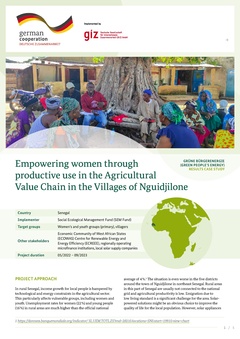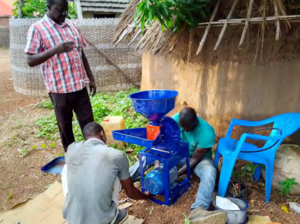Empowering Women through Productive Use in the Agricultural Value Chain in the Villages of Nguidjilone in Senegal
Empowering Women through Productive Use in the Agricultural Value Chain in the Villages of Nguidjilone in Senegal
Project Approach
In rural Senegal, income growth for local people is hampered by technological and energy constraints in the agricultural sector. This particularly affects vulnerable groups, including women and youth. Unemployment rates for women (22 %) and young people (16 %) in rural areas are much higher than the official national average of 4 %. The situation is even worse in the five districts around the town of Nguidjilone in northeast Senegal. Rural areas in this part of Senegal are usually not connected to the national grid and agricultural productivity is low. Emigration due to low living standard is a significant challenge for the area. Solar-powered solutions might be an obvious choice to improve the quality of life for the local population. However, solar appliances for productive use of electricity (PUE) in agriculture are associated with high upfront costs and the rural population often lacks access to credit. In addition, no supply and maintenance structures for these appliances exist.
The non-governmental organisation (NGO) Social Ecological Management (SEM) Fund is implementing a Green People’s Energy’s (GBE, Grüne Bürgerenergie) Small Projects Fund project, which enables the target group – primarily women and youth groups, but also individuals – to finance income-generating activities in the agricultural sector in the town of Nguidjilone and the surrounding area. On the one hand, the target group is supported in investing in PUE appliances such as solar pumps, solar rice husking equipment, solar freezers or solar mills. An important first step is to hold awareness-raising workshops to inform local people about the potential uses of solar energy in different ways. This includes ways to use the appliances in agricultural processing (e.g. solar huskers) and in private households (e.g. charging phones or lighting). On the other hand, the project supports the groups in setting up and managing microenterprises in the agricultural sector through training and group mentoring. Both components aim to support the target group to become financially self-sufficient for themselves and their families.
To enable the target group to invest in PUE appliances, the SEM Fund has set up a tiered financing structure. This allows women’s and youth groups, as well as individuals, to make a 10 % down payment on an appliance and receive a 90 % loan for the remainder of the investment cost. A local microfinance institution working with the SEM Fund manages the loan. In line with the local microfinance structure, this allows the groups to vouch for their members. The loan must be repaid over 18 to 24 months. The microfinance institution is refinanced by the project: 50 % of the investment costs are covered by a loan from SEM Fund and the remaining 40 % is a loan that is provided by the solar supply company. This model makes it attractive for the supplier to sell the appliance to buyers in the remote region, because the supplier receives 60 % upon installation – much more than in a common pay-as-you-go (PAYGO) setup. In addition, a guarantee facility of the project partner Economic Community of West African States (ECOWAS) Centre for Renewable Energy and Energy Efficiency covers the supplier’s credit risk. The underlying rationale of the repayment plan is that the endusers will increase their income by using solar appliances. In the short term, the increased income allows them to meet their loan obligations and in the long term, they can use the increased income to invest in their businesses and ultimately improve the quality of life for themselves and their families. When the repayments are completed, the supplier loan of 40 % has been repaid and the project has recovered 50 % of the equipment cost. In principle, this allows SEM Fund to operate as a revolving fund, using the repayments for a new financing cycle, including for other end-users and communities. The project uses a PAYGO system to finance the solar home systems, as this facilitates financial reporting as well money collection.
Methodology of Data Collection
The data for this case study report was collected by a project document review, five qualitative interviews with nine interview partners: one representative of the GBE project, two trainers and a representative of the partner NGO SEM Fund, three representatives of target groups of the project, one representative of a microfinance institution and one representative of a solar supply company. Furthermore, a quantitative survey was conducted with three representatives of the target groups. The findings of the survey supplement the information from the interviews. The case study was carried out between February and April 2023. At that time, some project activities were still ongoing. As a result, not all project impacts are fully captured.
Key Findings
Project Achievements
Although there are delays in project implementation, caused by the setting up of the financing mechanisms and the integration of the various stakeholders, respondents are largely positive about project results. All in all, the project reports to have positively impacted 2,160 people. The project has enabled numerous endusers to invest in solar equipment and solar home systems. For PUE, seven solar pumps for irrigation have been installed. Moreover, three freezers are in use to cool perishable products, five more have been ordered, as have seven mills. In addition, 373 solar home systems have been installed providing electricity to the target groups. Furthermore, 163 solar lamps have been installed.In the trainings and group mentoring sessions, the women’s and youth groups gained a basic understanding of PUE appliances, including the maintenance of equipment as well as cultivation techniques, managing their operations and financial education skills. This also included workshops with a specific focus on developing business plans. All in all, 17 business plans were drawn up to show how the new PUE appliances can be effectively used to generate additional income. 46 women and 12 young people received training on entrepreneurship and agricultural product processing while ten women and ten young people were trained in equipment maintenance.Part of the project specifically aims to change the way communities think about gender roles in economic activities, contributing to equality and economic independence for women. Awarenessraising workshops have been conducted to sensitise communities, especially male members. For example, some mixed-gender meetings attempt to sensitise men about the need to be more flexible in domestic tasks, i.e., to encourage men to take on more household chores in order to reduce women’s domestic responsibilities and allow them to take on more economic activities. More than 2,100 people were sensitised regarding these issues.
Intermediate Impact
The project succeeded in electrifying agricultural production and improving living standards, particularly for women in this part of rural Senegal. The PUE appliances are having positive influences on farming activities, which is best illustrated by the impact of the installed solar pumps. On the one hand, farmers who previously used diesel-powered pumps have reduced their costs by using the new solar irrigation pumps. In the past, the farmers had to invest large sums of money for the expensive diesel, as well as time, because they had to travel to distant towns to buy it. At the same time, noise emissions from diesel-powered pumps have been reduced, which leads to a higher level of quality of life for the farmers as well as the communities. On the other hand, those participating farmer groups, who previously had no pumps, have changed from rain-fed to irrigated farming. More specifically, the monoculture of onion production has been transformed into a multi-crop irrigated agriculture based on the new cultivation techniques promoted in the trainings. In the past, onions were by far the main crop in the region. After the harvest, market prices regularly fell due to the large quantity of onions available. As a result, farmers had to sell their onions quickly, often at low prices, to avoid spoilage. Many farmers are now able to grow more valuable crops like mangoes, maize, cabbage, and aubergines. This does not only increase end-users’ income, but also adds variety to the diet of their households. One interviewee summed up the positive developments vividly: “The environment was dry; now those who come can see the change: fruit, gardens, water. We hope it continues.” New village markets have also been established in the project region to sell the crops, which provide further possibilities to increase incomes.
To illustrate the project’s achievements with examples: One of the groups of women farmers report that they had increased their profits by replacing the expensive diesel pump on their twohectare farm with a solar pump. These profits are now not only being used to repay the loan, but the group is also using the profits to invest in a new sheep farm. In another case, a group of young people is using the solar freezer they have purchased for various income-generating activities, such as selling fish and ice cream. The business plans developed within the project help to steer the business activities.
Overall, all survey respondents report to have improved incomes. Two out of the three interviewed representatives of the target groups have seen a slight increase in their income, and one respondent reports that the income has increased significantly because of the solar-powered appliances. The solar home systems are equally improving the quality of life for the rural population in the project area. Bringing light into the village provides a sense of security for the villagers. The villagers now feel safe to go out into the streets, as the lights in the houses and on the verandas also illuminate the surrounding areas, and to hold meetings after dark. It also gives them the opportunity to study after dark.
Moreover, the ability to charge their cell phones and laptops allows the villagers to have constant access to the internet, including weather forecasts and virtual medical care. Furthermore, the end-users are now always able to access banking services via their mobile phones. By not having to travel to distant towns to charge their phones at high prices, the villagers save time and money that can be invested in productive activities, potentially leading to an increase of income.
According to the interviews, the project has been particularly successful in changing the way women perceive their role in economic activities and the women have shown a high level of commitment to continuing with the activities. One representative of a microfinance institution stated that women now “organise everything” regarding economic activities and demonstrate a high degree of ownership.
Challenges in Project Implementation
Overall, the objectives of the project are overly ambitious. The structure of the project, including the different financing mechanisms that had to be developed and the numerous stakeholders involved, makes it very difficult for the project to achieve its objectives in the short implementation period, also due to delayed project implementation. The delay is particularly evident in the delivery and installation of PUE appliances: Out of seven planned solar mills, none are completed. Two solar mills have been ordered but have not yet been delivered because the initial payment has not been made. The same is true for the solar huskers: Two were planned but have not yet been installed. Several planned pumps have also not been installed yet.
A key challenge is the inability of the target groups to pay their share of the loan agreements. Not only were they deterred by the high price of PUE equipment in general, but they also had problems to pay the initial down payments. Lack of savings as well as agricultural challenges, such as crop losses due to insect damage affect the ability of potential end-users to pay. A ripple effect illustrates the challenges of implementation in rural areas in this regard: In one village, three groups had ordered solar freezers, but only one group has been able to make the initial payment.
The supplier, however, could not afford to travel to the village to install just one unit. As a matter of fact, it is not only the initial payment that is problematic, but the financial institutions have also encountered problems with the late repayment of loans by several farmer groups. Considering that the 10 % initial payment was already a major financial hurdle, it is questionable whether loan repayments can be successfully paid. At the time of the case study, however, the repayment process is reported to be running more smoothly.+
Time was a limiting factor in the implementation of the project as it was very time-consuming to coordinate the various elements of the project, in particular the development of the financing mechanisms, the ordering of the PUE equipment, the collection of the 10 % initial payment, consultations with the many stakeholders involved, including the provision of relevant information to the farmers and the identification of suitable microfinance institutions and local solar supply companies.
Lessons Learned
The project demonstrates the need to take the unique local context into account from the start of project planning to the end of the project in order to ensure successful project implementation. To illustrate, it is important to integrate and consider local conditions when designing the financial model. The project demonstrates the need to develop a suitable credit scheme that is adapted to the economic situation of the potential end-users. In this case, the 10 % initial payment caused problems with the uptake, as people struggled to come up with the required amount of money, which delayed the project implementation. One further project activity was to supply solar home systems with televisions, designed to enable youth groups to run home cinemas as a commercial activity.
Although people were interested in the systems, it was reported that the cost was too high for people to actually want to invest in them. To date, only one solar home system with television has been installed. It became apparent that there is a need for a variety of equipment offered to the target group. During project implementation, the project enabled the installation of solar home system kits that fit better to the demand of the communities. While the project initially planned only to install larger kits with five light points, the switch to a smaller kit with two light points proved to be more successful due to the lower prices for the beneficiaries.The trainings were widely positively received by the interviewees, as they provided the participants with relevant information and developed some basic skills on which to build. The interviews also highlighted the importance of having local trainers “who better understand the issues and the terrain” to make the trainings as effective as possible. Trainers with local knowledge and experience can provide relevant advice tailored to the context and daily environment in rural Senegal.
An interviewee noted that awareness sessions in this region need to be carefully prepared and adapted to the level of knowledge and experience of the participants. This includes a presentation on the topics of PUE and financing, including visualisation through images, and the setting of the meeting room. In the project region, interviewees noted that local authorities, including sub-prefects, mayors and local development committees, need to be invited to all meetings to ensure that they do not feel ignored and support project activities.
Sustainability of the Intervention
The capacity building activities provided the target groups with the knowledge and equipment to carry out the farming and processing activities in the long term. The trainers will accompany the end-users for two years, providing them with the knowledge to run their activities independently. Importantly, the end-users received technical training in equipment maintenance, enabling them to quickly address basic technical issues with their PUE equipment, ensuring the continued functionality of the solar appliances.
The trainings of the farmers helped to develop plans and strategies on what crops to grow, what appliances are needed, and how to market these to make investments more profitable. As a result, the use of PUE appliances will become more attractive to other farmers, especially considering rising fossil fuel prices which make solar systems more viable.
Conclusion and Outlook
The project design encompasses the provision of access to PUE appliances for agricultural activities and the creation of microenterprises by and for women and youth to generate income. The focus on raising awareness of the population on the importance of women’s equality and economic independence in improving the economic situation in the region has also been well received and can be key to development in rural areas. Nevertheless, the project’s approach was too complex for the implementation in such a short time span, which has led to delays and some shortcomings.
However, survey respondents report that others are attracted by individual success stories. All three representatives report that other farms and businesses have shown interest in learning more about PUE appliances, while two recommended the appliances to others. Two representatives report that other farms or businesses have also purchased solar appliances as a result of their example and advice.
Scaling up and replication in the project area is feasible due to the momentum generated by the intervention. The NGO SEM Fund is in the process of setting up a structure on the local level that will perpetuate the project’s approach. The NGO is working with microfinance institutions to set up an office to help farmers use PUE equipment, obtain loans and manage their enterprises. This structure is intended to eventually take over the role of the SEM Fund and has the potential to be independent of international development cooperation.
























